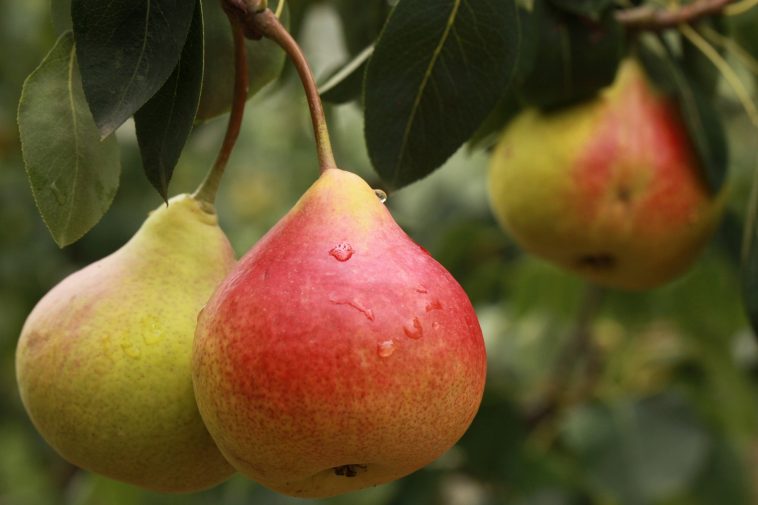A relish is a sweet-n-sour condiment containing preserved fruit/vegetable pieces and spices. It is served with curries, hot and cold meats, and savouries. Pear relish is usually prepared from firm mature or green pears.
A basic formulation is as follows: 100 parts vinegar; 250 parts chopped pears; 42 parts chopped onion; 2 to 30 parts chopped chilli peppers; 50 parts chopped green peppers; 50 parts sugar; 4 parts dry mustard; 2 parts allspice; 1 part cinnamon; 1 part cloves; 1 part turmeric; 1 part salt
1. Harvesting
Pears are one of the few fruits that are harvested in the mature green stage for processing. Harvesting is primarily done manually. Since pears do not have a definite maturation pattern, each tree may require to be visited several times during the harvesting period. Maturation can be hastened and the time of harvesting shortened by spraying the trees with chemicals.
2. Separation and sorting
This is done to select the best suitable raw materials for manufacturing the value-added end product. The pears are sorted by hand to remove overmature and damaged fruits. Unwanted materials such as trash, plant rests, sticks, et cetera, are also separated.
3. Washing of pears prior to processing
Washing is necessary to remove dust, contaminants and residual chemicals adhering to the fruit. The pears are washed with potable water that is sprayed over the fruit while being transported on a conveyor belt. The water may be chlorinated (1 to 2 ppm). Soft rotating brushes usually accompany the water sprays to provide more effective cleaning without damaging the fruit.

Pear relish. (Image Source: creativecountrylife.com)
4. Inspection and grading of pears
The pears are inspected to ensure that only sound fruit are processed. Size grading is performed with diverging rope or belt sorters to create uniform batches for mechanical peeling and coring machines.
5. Coring and peeling of pears
Pears can be automatically cored and peeled in one operation. The pears are aligned and orientated to ensure the correct position for the device that performs coring and peeling by the spinning action of special knives and rotating tables. The peeled and cored pears are usually halved or cut into smaller pieces by rotating blades prior to further processing.
6. Trimming and cutting the pears for relish
The pear pieces are inspected for any minor defects that may be trimmed away. The pear halves are usually reduced in size and cut in smaller pieces of more or less the same size.
7. Boiling of ingredients
All the ingredients are combined in a large saucepan or batch cooker and allowed to boil for 12 to 18 minutes until the pears are tender (not soft).

Pear harvesting. (Image Source: munchiemusings.net)
8. Packaging
Packaging is defined as the containment of a food product in a protective barrier that prepares goods for transport, distribution, storage, retailing, and end-use. The relish is filled into suitable containers at a temperature of 85 to 95 °C.
This requires the boiling relish to be slightly cooled in horizontal mixers fitted with water jackets prior to filling. Suitable containers are commonly glass jars with lacquered metal screw-on tops. Glass jars used for the preservation of food should be of high quality, without any cracks or chips, and should form tight seals.
The bottles require proper cleaning and heating prior to filling to avoid cracking (thermal shock) due to the high temperature of the relish. Rotary fillers or multiple-piston displacement machines capable of filling between 100 and 600 jars per minute are used in large-scale operations. The jars are sealed immediately after filling using a steam-flow machine to ensure air exhaustion and the formation of a vacuum in the cooled, sealed product.

Process description.
9. Cooling
Cooling involves extracting heat from the product to decrease its temperature using an appropriate device such as a heat exchanger and a medium, for example water, air or refrigerant. The filled and sealed containers of hot relish are allowed to cool naturally for 10 to 15 minutes, ensuring pasteurisation of all interior surfaces. Further cooling to below 40 °C may be accelerated by water-cooling. This in turn requires drying prior to labelling.
Published with acknowledgement to the ARC Agricultural Engineering for the use of their manuals. Visit www.arc.agric.za for more information









